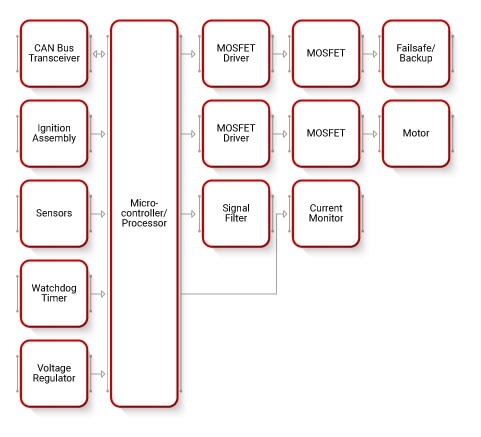Logic buffers, drivers, receivers and transceivers allow isolated access to logic signals from one circuit for use in another circuit. Buffers pass their input signal, either unchanged or inverted, to their output and may be used to clean up a weak signal or drive a load. In a boolean logic simulator, a buffer is mainly used to increase propagation delay. Logic receivers and transceivers allow isolated communication between data buses.
Isolator Gate Drivers are the interface between power signals and an external MOSFET or Bridge architecture circuit. The technology types are capacitive coupling, magnetic coupling, and optical coupling with 1, 2, or 4 channels. The voltage isolation ranges from 1000Vrms to 7500Vrms and the propagation delay ranges from 30ns to 5ms.
Discrete Field Effect Transistors (FETs) are widely used in power conversion, motor control, solid-state lighting, and other applications where their characteristic ability to be switched on & off at high frequencies while carrying substantial amounts of current is advantageous. They are used almost universally for applications requiring voltage ratings of a few hundred volts or less, above which other device types such as IGBTs become more competitive.
Products in the motor driver and controller PMIC (Power Management Integrated Circuit) family are used to control or manipulate the application of power from some source to electric motors or related electromechanical actuators. The precise functionality and feature sets implemented vary widely depending on the characteristics of the intended load and expected application, ranging from simple open-loop speed control for brushed motors to advanced, closed-loop, stepper-based motion control.
Power Supply Controllers and Monitors serve a variety of power-related supervisory and administrative functions. Common examples include measurement of voltage and load current being drawn from one or more supply rails, and sequencing of multiple supplies during system startup and shutdown.
Radio frequency filter products provide a frequency-dependent level of signal attenuation, and are distinguished from similar products by their intended use in radio-related applications. They are commonly used to limit the amount of interference caused by strong signals outside a frequency range of interest. Component-level products designed to be incorporated into an electronic assembly as well as modular, connectorized products for lab & test equipment use are both included.
Stepper motors are DC voltage motion actuators that move in discrete steps. Multiple sets of coils organized in groups called "phases" determine the motors armature position. Energizing each phase in sequence causes armature rotation one step at a time. With computer or microcontroller managed stepping, precise positioning and/or speed control is achieved. Steppers are selected by torque, steps per revolution, step angle, NEMA frame size, coil resistance, polarity and shaft features.
Products in the DC-DC switching regulator PMIC (Power Management Integrated Circuit) family are component-level devices used in applications requiring stabilization of a DC input voltage and/or transformation thereof to an output voltage of different magnitude. They are distinguished from similar products called "controller" PMICs by virtue of integrating the main switching element through which the power delivered by the device passes.









